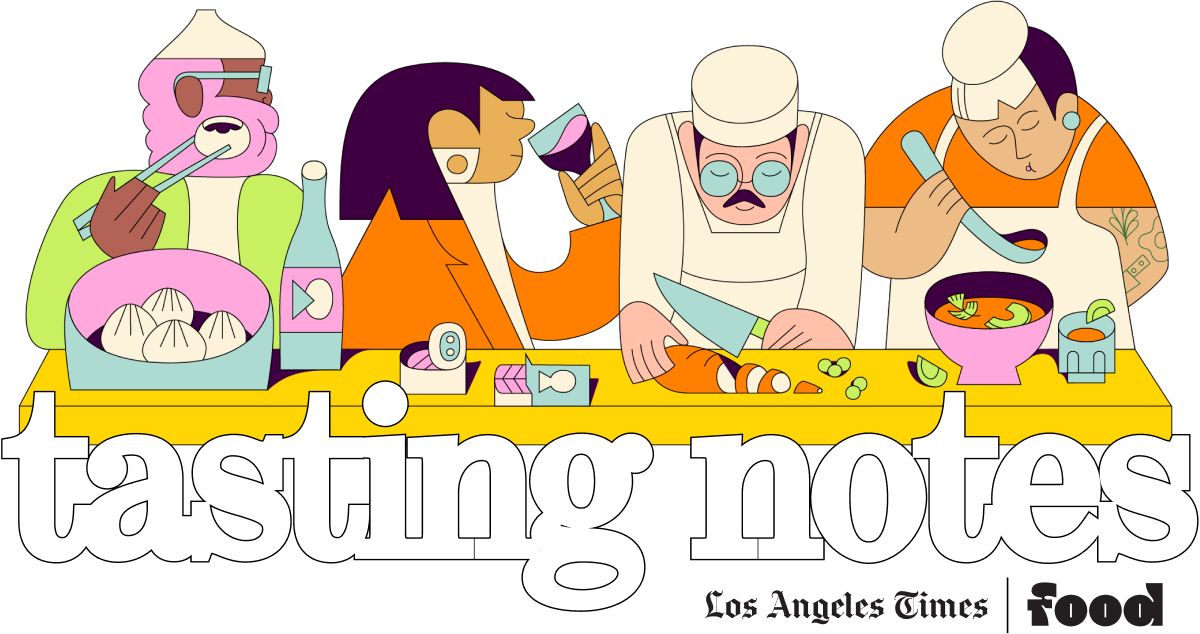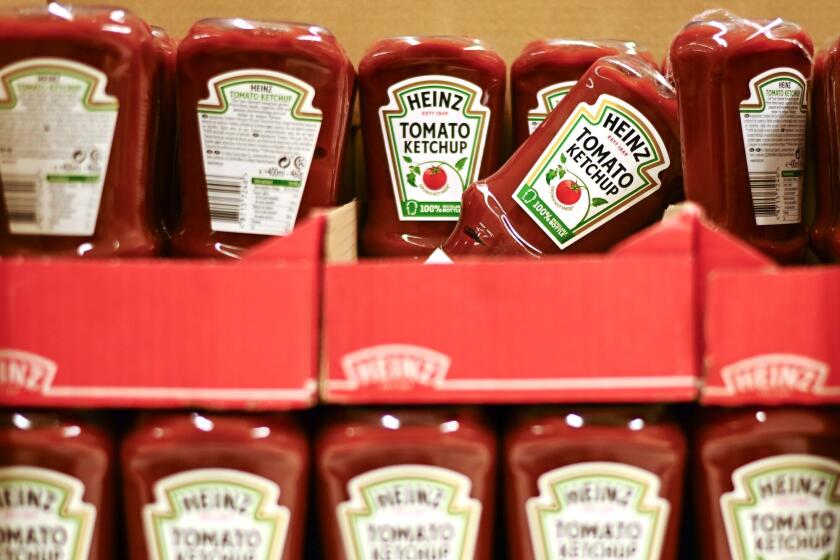The perfect summer corn fritter to welcome you back to downtown L.A. restaurants

- Share via
Returning to downtown L.A. restaurants after the curfew. The spirituality of red Fanta. “The most exciting place to eat in the South Bay in recent memory.” And a Crunchwrap Supreme plot twist. I’m Laurie Ochoa, general manager of L.A. Times Food, with this week’s Tasting Notes.
In the sunshine of our L.A. love

I was happily eating a light lunch of poached chicken with an array of radishes, tarragon mayonnaise and buttered milk bread toast dusted with sea salt when our friendly and attentive waiter, just four days on the job, walked up holding a plate of sunshine: three beautifully fried corn fritters with flash-fried basil, a wedge of lime and a mound of salt for dipping. There was a dish of chile sauce too, but the corn’s sweetness, salt and herbs were all I needed on the day before the official start of summer.
I was at chef Giles Clark‘s Cafe 2001 with the editor of L.A. Times Food, Daniel Hernandez, and every table in the place was filled. The cafe’s big brother restaurant, Yess, from chef Junya Yamasaki, was boarded up at the front entrance facing 7th Street — the dinner-only spot closed during the recent downtown L.A. curfew — but we saw activity in the kitchen when we peeked through the glass blocks on the side of the restaurant and were hopeful that Yess would reopen that night.
As columnist Jenn Harris wrote this week, the seven-night curfew left downtown L.A. streets empty: “All along 2nd Street, the windows and doors were hidden behind plywood. ... The frequently bustling Japanese Village Plaza, where shoppers dine at a revolving sushi bar and stop for cheese-filled corn dogs, was desolate.”
Now there are tentative signs of recovery.

“Hours after the curfew was lifted Tuesday, downtown started to show signs of coming to life again,” Harris wrote. “Just before 7 p.m., a line began to form at Daikokuya in Little Tokyo ... known as much for the perpetual wait as it is for its steaming bowls of tonkotsu ramen. It was a hopeful sight.”
Yet, as Harris also reported, Kato, the three-time No. 1 restaurant on the L.A. Times 101 list, whose chef, Jon Yao, was named the best chef in California at this week’s James Beard Awards, “was still looking at a 70% drop in reservations for the upcoming week” after the curfew’s end.

“The direct impact of the media’s portrayal of DTLA being unsafe, which it is not, has impacted Kato,” Ryan Bailey, a partner in the restaurant told Harris.
Certainly downtown is frequently portrayed, “as a sometimes dodgy place to live and work.” But “despite myriad challenges,” reported real estate specialist Roger Vincent this week, “downtown L.A. is staging a comeback. ... Occupancy in downtown apartments has remained about 90% for more than a year ... slightly higher than the level before the pandemic. ... In fact, the downtown population has more than tripled since 2000, reflecting a dynamic shift in the city center’s character toward a 24-hour lifestyle.”
On Tuesday night, I met reporter Stephanie Breijo at Hama Sushi, another Little Tokyo spot where the wait is usually lengthy, and was able to get a spot at the sushi bar by arriving before 6 p.m. The place quickly filled up behind us.

Though some were at Hama to support downtown, many came to pay their respects to the memory of recently deceased owner Tsutomu Iyama. Breijo will be reporting on the life and legacy of Iyama in the coming days, but on Tuesday night the longtime staff was on top of its game, serving affordable but excellent sushi, without gimmicks as Iyama intended.


Two days later I was at Cafe 2001, which has become one of my favorite — and most useful — restaurants in the city, open all day and into the evening on weekends. In our recent brunch guide, I wrote about Clark’s red-wine-poached egg, my partner, John, swears by Clark’s caponata, and deputy food editor Betty Hallock loves “his versions of a quintessential yoshoku icon, the Japanese potato salad ... [sometimes] kabocha pumpkin and puntarelle with blood orange and fermented chiles [or] a verdant pea and potato salad with lemon-y pea tendrils.”
But my current favorite Clark dish? Those light and crisp corn fritters. They were the perfect welcome back downtown gift after a tense week of closed restaurants.
Looking for the American dream

“I’ve ... had customers come in and tell me, ‘The American dream doesn’t exist anymore.’” That’s Evelin Gomez, a juice bar worker at the Carson location of Vallarta Supermarket, speaking with reporter Lauren Ng. Ng checked social media accounts and conducted interviews with people in grocery stores and restaurants founded by immigrants and the children of immigrants about what they are witnessing with the recent Immigration and Customs Enforcement (ICE) enforcement actions in Southern California.

The independent-minded Casa Vega owner Christy Vega, who supported Rick Caruso over Karen Bass for mayor in the most recent election, “has been an outspoken critic of ICE,” Ng wrote.
“I protested in honor of my Mexican immigrant father, Rafael Evaristo Vega, and the very people Casa Vega was built on since 1956,” Vega wrote on Instagram of her attendance at a “No Kings” protest. “I will always remember my roots and ALWAYS fight for the voiceless immigrant community.”
Some restaurateurs, as Stephanie Breijo reported, have been coordinating grocery handouts and deliveries for those fearing being swept up in ICE raids.
“We understand the feelings that are happening in our community right now, even if we are legal,” said Xochitl Flores-Marcial, a partner in Boyle Heights’ X’tiosu with its chef-founders, Felipe and Ignacio Santiago. “Even if we have documents, that doesn’t exempt us from the danger that so many people are facing right now and in our culture.”
Meanwhile, assistant food editor Danielle Dorsey, put together a guide to 15 different food fundraisers and events to support those affected by ICE actions. Many are happening this weekend.
South Bay hot spot

The young and ambitious staff at Vin Folk — with two alums of Aitor Zabala’s Somni leading the team of chef-servers — charmed columnist Jenn Harris during her visits to the Hermosa Beach restaurant created by chefs Kevin de los Santos and Katya Shastova.
“The dining room crackles with the hopeful, earnest energy of a start-up company, ripe with possibility,” she writes in her restaurant review published this week. “And with food that has all the technique and precision of a tasting menu restaurant with less of the fuss, it is without a doubt the most exciting place to eat in the South Bay in recent memory.” Some of the dishes she highlights: a savory tart that could be “a love child of mussels in escabeche and pot pie”; headcheese toast, “a loose interpretation of the patty melt at Langer’s Deli”; pritto, “a take on Taiwanese popcorn chicken”; “exceptionally tender” beef tongue, “an homage to Shastova’s childhood in rural southern Russia,” and a risotto-style interpretation of Singapore chili crab.
Vin Folk is also nurturing a new generation of chefs and restaurateurs: “Staff are trained in multiple positions, both in and out of the kitchen,” Harris writes. “Everyone helps with prep, then De los Santos and Shastova [place] members in positions where they may be strongest.”
“We are teaching them,” Shastova tells Harris. “You go through everything because we believe it’s important to learn every single detail of the restaurant if you want to have your own one day.”
Seeing red

In her latest Grocery Goblin dispatch, correspondent Vanessa Anderson examines why strawberry red Fanta — “known as Fanta nam daeng, or ‘Fanta red water’” — is seen in so many Thai shrines or spirit houses, many of which are set up at local grocery stores and restaurants. “Much like those on this earthly plane, the way to a spirit’s heart is through his or her stomach,” Anderson reports.
“In the past when we would do offerings to ghosts, it would be an offering of blood,” Pip Paganelli at Thai dessert shop Banh Kanom Thai, tells Anderson, who concludes that “the bubbly strawberry nectar has since replaced animal sacrifice.”
Paganelli, Anderson adds, also posits that red Fanta’s “sickly sweetness ... is beloved by ghosts because of just that. Most spirits have a sweet tooth.”
- And even though Juneteenth has passed, the recipes that deputy food editor Danielle Dorsey gathered to celebrate the holiday are delicious all year long — and often feature red foods that some say “honors the bloodshed and suffering of enslaved ancestors.” Others say that red symbolizes power.
Crunchwrapped

The anniversary none of our social media feeds or TV news anchors will let us forget this week is the release 50 years ago of Steven Spielberg‘s “eating machine” blockbuster “Jaws.” But columnist Gustavo Arellano has another anniversary on this mind this week — the debut 20 years ago of Taco Bell’s Crunchwrap Supreme.
“The item has become essential for American consumers who like their Mexican food cheap and gimmicky,” he wrote this week, “which is to say, basically everyone (birria ramen, anybody?)” The plot twist is that Arellano, author of “Taco USA: How Mexican Food Conquered America,” had never actually eaten a Crunchwrap Supreme until this month. And when he finally did try it? Let’s just say it lacked the crunch he was looking for. I’ll let you read his column to find out why he prefers the bean-and-cheese burritos and Del Taco.
Bonus: Arellano references Jenn Harris’ 2015 story and recipe for a homemade Taco Bell Crunchwrap Supreme, to be enjoyed in the comfort of your home, without the “bad playlists, scratchy paper napkins and fluorescent lighting” of a fast food restaurant. I think hers would have the crunch Arellano seeks.
Also ...
- Reporters Jessica Garrison and Melissa Gomez report that “as the crucial summer harvest season gets underway in California’s vast agricultural regions, farmers and their workers say they feel whiplashed by a series of contradictory signals about how the Trump administration’s crackdown on illegal immigration might affect them. California grows more than one-third of the country’s vegetables and more than three-quarters of the nation’s fruits and nuts. ... Without workers, the juicy beefsteak tomatoes that are ripening and must be hand-harvested will rot on the vines. The yellow peaches just reaching that delicate blend of sweet and tart will fall to the ground, unpicked. Same with the melons, grapes and cherries.”
- Danielle Dorsey culled 18 immigrant-founded restaurants in L.A. from our Hall of Fame list by critic Bill Addison and columnist Jenn Harris.
Eat your way across L.A.
Like what you're reading? Sign up to get it in your inbox every week.
You may occasionally receive promotional content from the Los Angeles Times.

Eat your way across L.A.
Get our weekly Tasting Notes newsletter for reviews, news and more.
You may occasionally receive promotional content from the Los Angeles Times.




